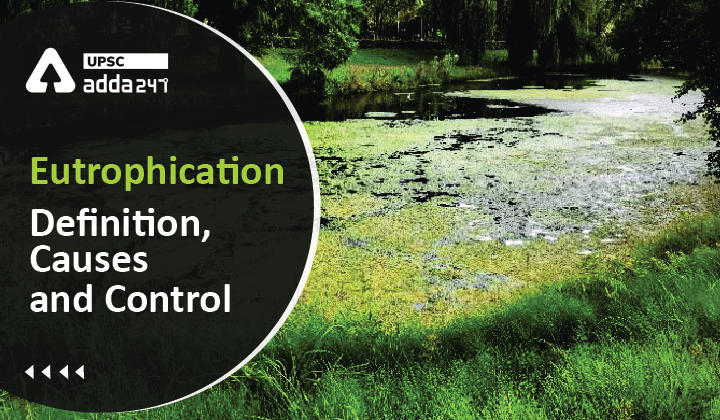Table of Contents
Eutrophication UPSC
What is eutrophication?
- Eutrophication meaning: Eutrophication is a process of pollution that occurs when a lake or stream becomes over-rich in plant nutrient, thus leading to overgrowth of algae and other aquatic plants.
- Eutrophication leads to results like harmful algal blooms, dead zones, and fish kills.
- It is more widely known in relation to anthropogenic activities where the artificial introduction of plant nutrients leads to community changes and a deterioration of water quality in many freshwater ecosystems.
Causes of eutrophication
- When water bodies are overly enriched with nutrients like nitrogen and phosphorus; algae, plankton, and other simple plant are over grown, thus affecting the life of other marine animals.
- How water become overly enriched with nutrients?
- In plant life, phosphorus is considered as one of the primary limiting factors. Some of the sources of phosphorus are:
- Fertilizers
- Untreated sewage
- Detergents containing phosphorus
- Industrial discharge of waste.
Eutrophication consequences
- The most visible effect of cultural eutrophication is the creation of dense blooms of foul-smelling phytoplankton that reduce water clarity and harm water quality.
- Algal blooms limit light penetration, reducing growth and causing die-offs of plants in littoral zones while also lowering the success of predators that need light to pursue and catch prey.
- Also, high rates of photosynthesis associated with eutrophication can deplete dissolved inorganic carbon and raise pH to extreme levels during the day.
- When the dense algal blooms eventually die, microbial decomposition severely depletes dissolved oxygen, creating a hypoxic or anoxic ‘dead zone’ lacking sufficient oxygen to support most organisms.
- Furthermore, such hypoxic events are particularly common in marine coastal environments surrounding large, nutrient-rich rivers.
- Hypoxia and anoxia as a result of eutrophication, continue to threaten lucrative commercial and recreational fisheries worldwide.
- If a nutrient deficient water body is suddenly enriched with it, many other competitive species might relocate to the water body and out-compete the original inhabitants of the ecosystem. Example: common carp.
Eutrophication control
- diversion of excess nutrients
- altering nutrient ratios
- physical mixing
- shading water bodies with opaque liners or water-based stains
- application of potent algaecides and herbicides
- biomanipulation: the alteration of a food web to restore ecosystem
Read UPSC favourite topics





 TSPSC Group 1 Question Paper 2024, Downl...
TSPSC Group 1 Question Paper 2024, Downl...
 TSPSC Group 1 Answer key 2024 Out, Downl...
TSPSC Group 1 Answer key 2024 Out, Downl...
 UPSC Prelims 2024 Question Paper, Downlo...
UPSC Prelims 2024 Question Paper, Downlo...
